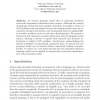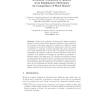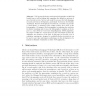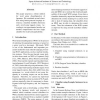ACL
2007
13 years 11 months ago
2007
Recent research presents conflicting evidence on whether word sense disambiguation (WSD) systems can help to improve the performance of statistical machine translation (MT) syste...
CICLING
2008
Springer
13 years 11 months ago
2008
Springer
An N-gram language model aims at capturing statistical word order dependency information from corpora. Although the concept of language models has been applied extensively to handl...
FLAIRS
2008
13 years 11 months ago
2008
The problem of recognizing textual entailment (RTE) has been recently addressed using syntactic and lexical models with some success. Here, we further explore this problem, this t...
ECAI
2000
Springer
14 years 1 months ago
2000
Springer
Abstract. This paper describes an experimental comparison between two standard supervised learning methods, namely Naive Bayes and Exemplar–basedclassification, on the Word Sens...
ERSHOV
2003
Springer
14 years 2 months ago
2003
Springer
Words in the explanatory dictionary have different meanings (senses) described using natural language definitions. If the definitions of two senses of the same word are too simi...
CICLING
2003
Springer
14 years 2 months ago
2003
Springer
NLPsystem developers and corpus lexicographers would both bene t from a tool for nding and organizing the distinctive patterns of use of words in texts. Such a tool would be an ass...
CICLING
2003
Springer
14 years 2 months ago
2003
Springer
This paper presents a graph-theoretical approach to lexical disambiguation on word co-occurrences. Producing a dictionary similar to WordNet, this method is the counterpart to word...
TAL
2004
Springer
14 years 2 months ago
2004
Springer
This paper presents an algorithm to apply the smoothing techniques described in [1] to three different Machine Learning (ML) methods for Word Sense Disambiguation (WSD). The method...
IJCNLP
2004
Springer
14 years 2 months ago
2004
Springer
This paper proposes a robust method for word sense disambiguation of Japanese. We combined several classifiers using heterogeneous language resources, a machine readable dictiona...
CIARP
2004
Springer
14 years 2 months ago
2004
Springer
We present a method for extracting selectional preferences of verbs from unannotated text. These selectional preferences are linked to an ontology (e.g. the hypernym relations foun...




